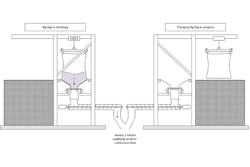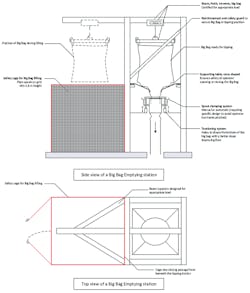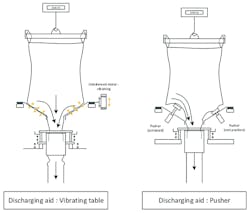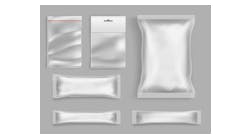How to achieve efficient big bag tipping
Many manufacturers in the bulk solids processing industry still use small 25-kilogram (kg) bags at the base of their process. However, the need to intensify process operations is bringing a growing number of materials suppliers to turn to big bags, which allow users to significantly reduce their operational needs while tipping the same quantity of materials.
The handling of big bags is posing specific challenges to process designers and operators, and while the tipping operation is common, such challenges can be easily overlooked. Big bag handling must be a dust-tight and safe operation that considers the risk involved with the manipulation of loads of several hundred kilograms. The process also must be efficient to benefit from the advantages of handling large quantities of product at a time. The objective of this article is to detail the key design precautions that one must take to reach efficient big bag tipping.
Figure 1. Typical design of a big bag tipping station with a safety cage to protect the lifting area.
Safety first
When designing a big bag tipping process, one must have in mind the weight of the bags that will be handled, typically 500 to 1,000 kg, sometimes more. This heavy weight constitutes a safety risk because the bags need to be lifted to be positioned on a tipping station, which means that the load could potentially fall on an operator standing below the crane if a mechanical failure occurs.
Such risks must be addressed by ensuring that the station has been properly designed for the right weight. This means the beam, hoist crane and traverse that will be supporting the bag must be calculated and certified for a load heavier than the maximum weight of the bag that will be handled. The bag itself must be certified for the right load — this is normally the responsibility of the supplier but big bags may also be used as an intermediary container within the same process — and the hooks of the traverse must secure the hanging loops of the bag to ensure the loops don’t slip while the bag is lifted. These design and operational precautions are a must, but they are not sufficient for protecting a station that will handle thousands of big bags in a year. A maintenance defect in the hoist or an operator mistake in attaching the bag to the traverse can still cause the bag to fall. To protect the people operating the tipping station, a safety cage to prevent access to the lifting area must be installed.
Such a safety cage has to be designed in a specific way:
- It must lock the access to the inside of the station. Fences must be high enough (typically more than 1.6 meters) so that nobody can enter.
- It must be integral — manufacturers sometimes only protect three sides, but it can still be possible to access from below the tipping station support.
- The access door to bring the bag in must be equipped with a safety lock that closes as soon as the hoist is lifted and that remains closed until the hoist is lowered.
- Conversely, when the door is opened, the hoist should not be movable, so the bag cannot be lifted while people stand in the safety cage.
- Beams must be positioned around the bag tipping table to prevent the bag from falling while being discharged.
- The control of the hoist must be located and fixed outside the station. This prevents the operator from attempting to stand in the station with the door closed. For heavy-duty stations, it is advised to automate the transfer of the bag.
Once in position for connection to the tipping point, it is necessary to install a support to prevent the bag from falling on the operator, who has to work beneath it to pull the spout and open it. The support can be a simple frame to serve the safety function, but it is better to consider a profiled table that will also help the flow of the product.
In addition to designing for the risks of the bag falling, the designer must also consider potential risks located at the tipping point. To reduce dust emission, stations are equipped with a clamping system for the bag spout, which may pose a pinching risk for the operator. Unloading the bag is only the first process step. Usually, other equipment such as a screw conveyor, lump breaker or rotary sifters will be installed right below the station. This equipment can present a risk to operators, should they need to access them, as in the event of a blockage in the downpipe of the station.
Different design solutions exist for managing those risks:
The clamping system can be protected by a cage or must be operated through a control box requiring the operator to use two hands.
Any rotating equipment down the line from the station must be out of reach of the operator or a grid should be welded in the drop tube to prevent access.
As the station is used to discharge bulk solids, dust clouds in explosive concentration may be present in the equipment or in the surroundings (in case of leaks due to improper manipulation, for example). The station must, therefore, be subject to a dust explosion risk analysis and designed according to the determined zoning.
Figure 2. Discharging aid options: vibrating table and pushers
Ergonomics and hygiene
Dust containment
Big bag tipping stations must allow for the discharge of a bag without emitting dust to the environment to protect the operator and reduce the needs for cleaning as well as the risks related to dust explosion. Both connecting and disconnecting the bag can lead to dust leakages, thus those two operations require specific designs and procedures.
The station should be equipped with a clamping system designed to keep the spout in position before the bag is untied and during the entire discharge process. A simple mechanical clamp is usually sufficient, but for fine powders some suppliers propose an inflatable seal that brings additional tightness.
Disconnecting the bag is an easier operation in practice, but is particularly prone to dust spillage because some powder always remains in the bag. To address this, first the operator can tie the spout of the bag. Some process options also help like installing a fan that will suck the air out of the bag at the end of the discharge and collapse it, reducing the quantity of powder that can fall when it is disconnected and closed by the operator.
Foreign bodies
Foreign bodies present problems in every industry with implications ranging from damaged equipment to product recalls. Because big bag tipping stations present an open point in the process, they are particularly vulnerable to foreign bodies. The following provisions should be taken in designing a new installation:
- The tipping station funnel must be covered by a lid when not in use.
- If the product flows well, including a grid in the tipping head can be useful because it can block large foreign bodies, especially if part of the bag, such as the liner, falls during production.
- A sieve and a magnet should be positioned after the station to screen the material tipped. For better results, the bulk solids from the station should be roughly dosed by a screw conveyor or any other equipment able to control the flow of solids.
Operator work position
The support table must be positioned at such a height that the operator can reach the spout to pull it out and clamp it easily. A height of 1.4 m (maximum 1.6 m) is a good choice.
If possible, the station should be installed on the floor and not require a platform to access the tipping point. This reduces the movements of the operator and therefore the risks related to walking up and down the stairs.
Figure 3. Continuous discharge of big bag thanks to two stations in parallel
Efficient tipping
Flow of material
A big bag unloading station must be designed to reach a defined capacity. In most cases, when capacity is not achieved, it is due to the flow of material out of the bag. Big bags have a flat bottom that doesn’t promote flow. Some materials are cohesive and will not be emptied easily. It is therefore key to understand the flowability of the product to be discharged to select the right tipping station.
To promote flow, it is first necessary to have a tipping table that is profiled to make the bag take a cone shape. Additionally, some stations are equipped with a movable tipping head that can be pulled down during tipping and increase the slope of the bottom of the bag. These two options are necessary to have a good product flow and are also recommended for free-flowing products. However, they may not be sufficient for the most difficult materials, thus some mechanical aids should be included in the design:
Vibration: It is possible to install an unbalanced motor on the tipping station table to promote the flow. This will, however, not be very efficient or could even be detrimental to materials that get more compact with vibration.
Pushers (massaging): For difficult powders, tipping stations can be fitted with pneumatic pistons that will alternatively push the sides of the bag during discharge. The product is then forced to flow to the outlet of the bag.
One must not forget that bag tipping is most often the first operation in a process, thus failures to discharge the product on time may ultimately slow down or stop the downstream process resulting in large losses for the process operators. Taking the time to test the material(s) that will be processed and selecting the right options comes with a cost, but this investment will most likely be returned quickly by making the whole manufacturing process more reliable.
Reducing wastes
At the end of the discharge, discharging aids are no longer efficient and a few kilograms of material are likely to remain in the bag. If the bag is removed at this point, the product loss will be high and the economic profitability of the station decreased. Operators should be trained to lift the bag just before disconnecting it to let the last amount of material flow. Some manufacturers actually propose auto-tensing traverses that automatically pull the bag at the end of the discharge.
The time required to discharge the bag will also depend on the downstream process. If the station is connected to a buffer, the bag can be discharged as quickly as the flow of product allows. However, if it is connected to a sieve or to a conveying line, for example, the discharge time will be imposed by this process step, thus increasing the time to empty the bag.
Big bag exchange time
Bag exchange time, the time to remove an empty bag and replace it with a new one, must also be considered in the design of a tipping station. For high-capacity stations, traveling time must be minimized. This can be done by selecting a hoist with higher lifting and traveling speed, and also by automating the transfer. In the case of automation, the hoist and hoist beam must be equipped with switches that allow the system to know the position of the bag. Hooking the bag before lifting and connecting the spout to the station are still manual operations.
The dimensions of the station must be well adapted to the size of the bag to be manipulated. It may seem obvious but experience shows that many problems occur at start-up due to a lack of space — for example, not enough room to lift and bring the bag to the tipping point. On the contrary, having too large of gaps from the supporting table to the clamping points in case the spout is short also can cause problems. Specifying the size of the bags to be used, particularly if different sizes are foreseen, is therefore critical for efficient handling.
Continuous discharge
Big bag tipping is a discontinuous process. When the bag is removed, no more product can be tipped. This is fine in most cases but some processes may require a continuous supply of product, which can be achieved either by a buffer hopper or for more stringent cases, by having two stations in parallel to have a new bag ready when the discharging one is empty.
Conclusions
Designing an efficient big bag tipping process requires a detailed knowledge of the materials that need to be discharged and an investment in the right equipment for the station. This upfront planning and investment will pay off quickly by allowing the whole process supplied to the station to perform well. Safety is a must and proper protections must be put in place to manage risks associated with lifting heavy loads.
Thomas Lamotte has 10 years of experience in process design and operation including more than six in dry-mixing and bulk solids handling. Currently a senior process engineer at Nestle Research Singapore, he holds two master’s degrees in process engineering from ENSIC Nancy and IFP School, France. Lamotte may be reached at [email protected].
Editor’s note: Read more on bag tipping design Thomas Lamotte’s other articles for Processing:





